Your Guide to a Captain Cook Snorkel Tour
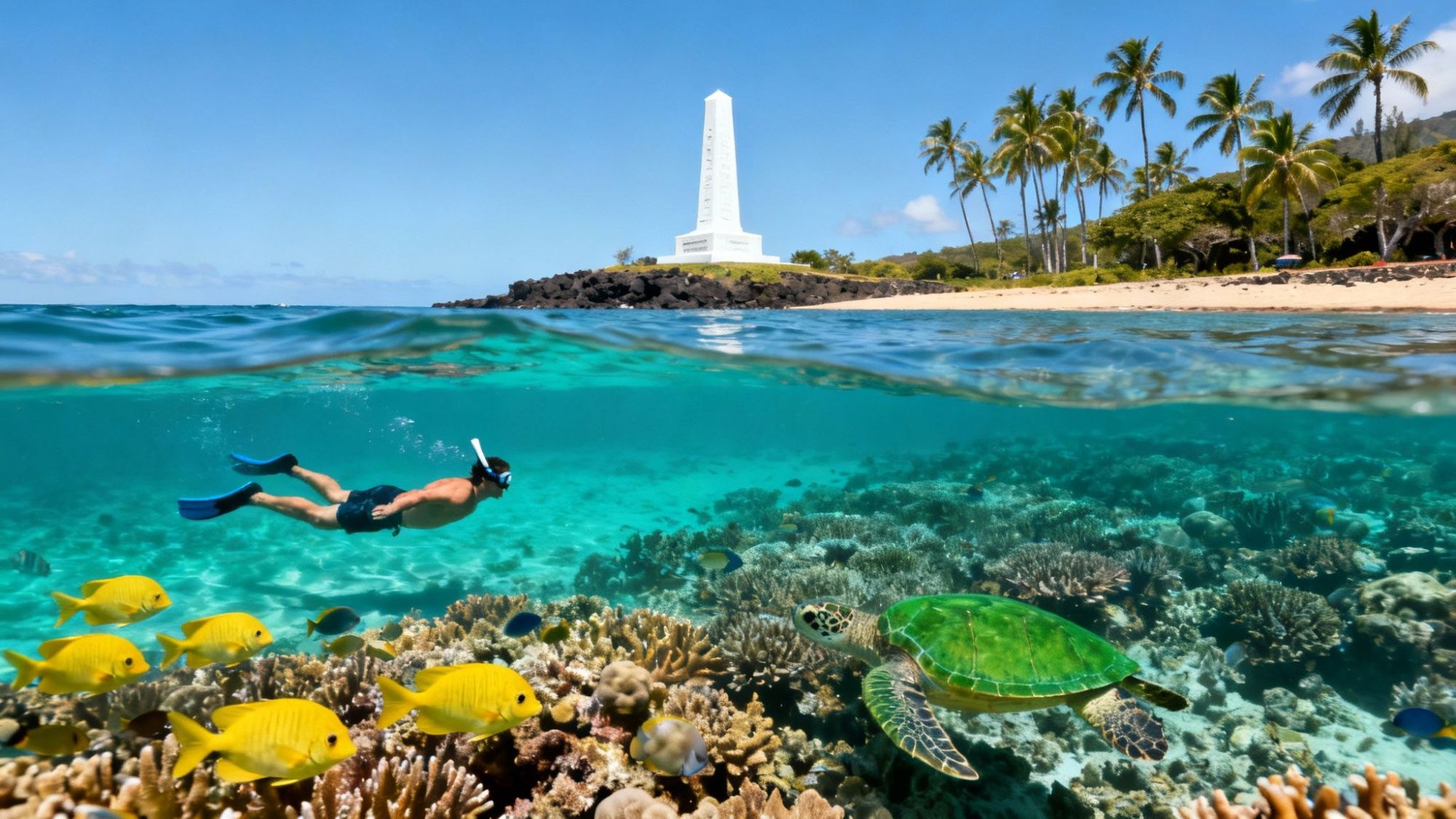
Picture this: you're floating weightlessly in calm, turquoise water. A kaleidoscope of tropical fish darts around vibrant coral reefs, and on the shore, a stark white monument stands as a silent witness to a major moment in Hawaiian history. That's the feeling of a Captain Cook snorkel tour, an absolute must-do on the Big Island that perfectly marries underwater exploration with a real sense of place and history.
Your Guide to an Unforgettable Snorkel Adventure
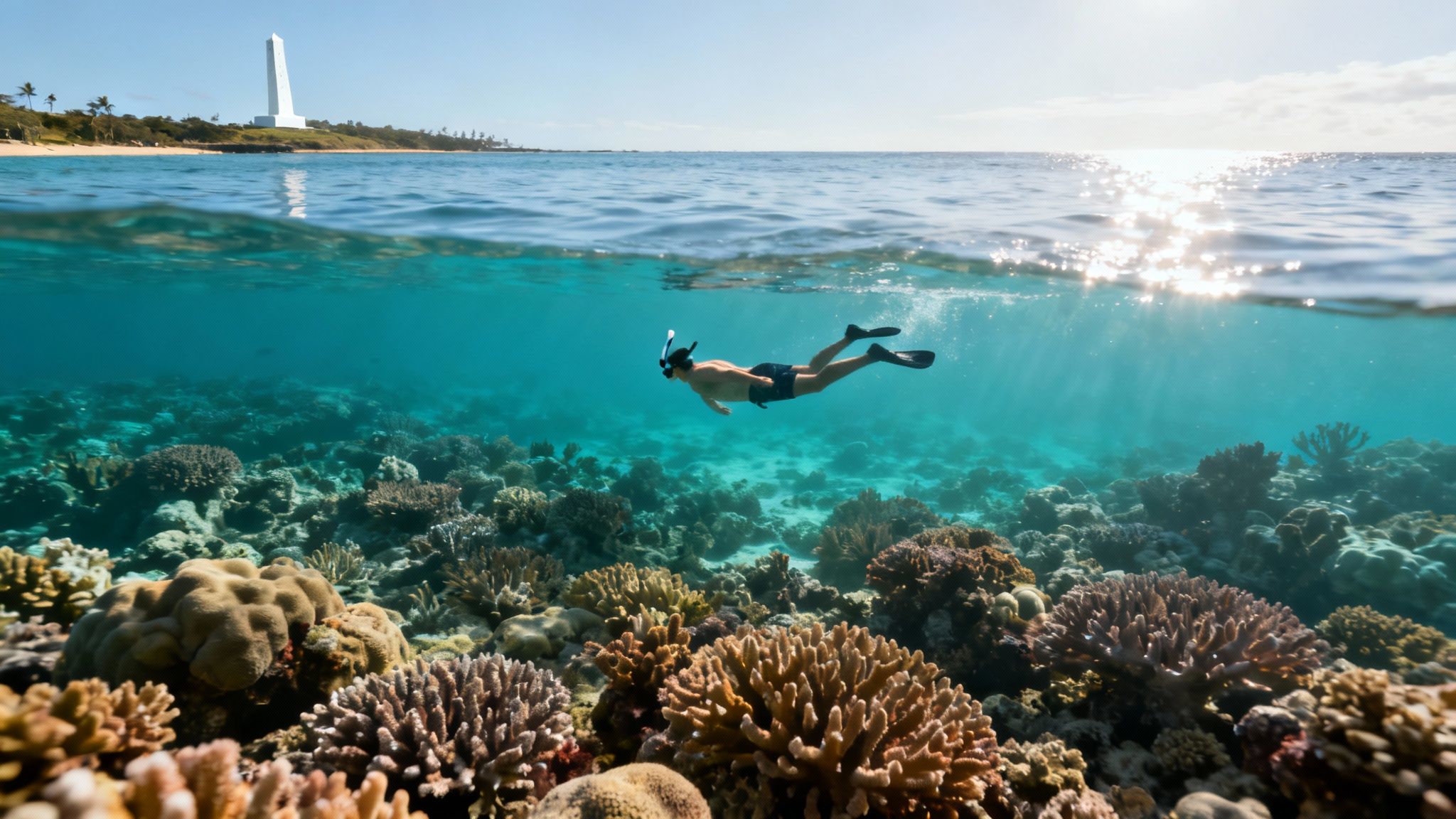
Think of this guide as your personal roadmap to one of Hawaii's most incredible excursions. I'll walk you through everything you need to know to plan the perfect day out. We’ll cover why this isn't just another spot to jump in the water, but a genuine deep dive into a world-class, protected marine sanctuary.
What Makes Kealakekua Bay So Special?
Kealakekua Bay isn’t just another pretty face; it’s a designated Marine Life Conservation District. That protected status is the secret sauce behind its unbelievable underwater clarity and bustling ecosystem. The bay's naturally calm, sheltered waters make it a perfect playground for everyone, from first-time snorkelers to seasoned pros.
It’s like swimming in a massive, perfectly maintained natural aquarium where all the residents are wild and free. Here’s what sets it apart:
- Pristine Conditions: The water is often so clear you feel like you can see for miles. This gives you an unbeatable view of the coral gardens and the 200+ species of fish that call the bay home.
- Historical Significance: You're snorkeling at the very place Captain James Cook first landed in Hawaii in 1779, and where he was later killed. That iconic white monument on the shore is a constant reminder of the deep history here.
- Abundant Wildlife: The sheer amount of life is staggering. You’ll see huge schools of yellow tang, graceful green sea turtles (honu), and you might even get lucky and spot a pod of Hawaiian spinner dolphins playing nearby.
This unique mix of raw natural beauty and historical gravity is what makes the bay a global draw. In fact, Kealakekua Bay brings in over 190,000 visitors every year, and many come specifically for a Captain Cook snorkel tour to experience both its ecological and cultural significance firsthand.
Preparing for Your Journey
Coming up, we’ll get into the nitty-gritty of choosing the right tour company, what you absolutely need to pack for a day on the water, and some practical tips to keep your snorkeling experience safe and fun. By the time you're done reading, you’ll be totally prepared and excited for an adventure that connects you to the true heart of Hawaii. You can discover more about what makes these tours so popular and dig deeper into their historical background.
The Storied History of Kealakekua Bay
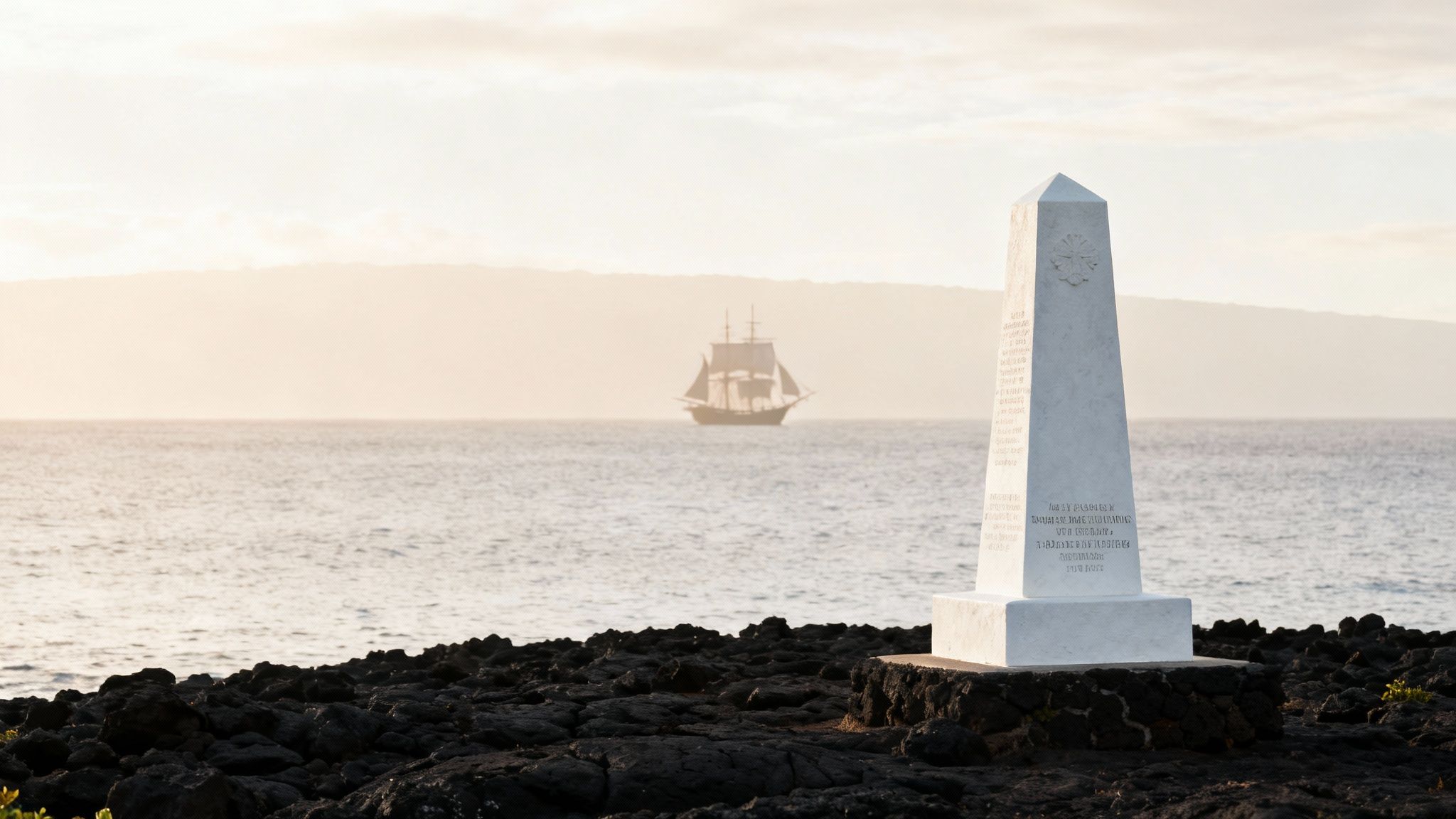
Jumping on a Captain Cook snorkel tour isn’t just about the incredible underwater sights; it’s like swimming through a living museum. As you float over the coral, you're in the exact spot where Hawaiian history was changed forever. The peaceful beauty of Kealakekua Bay today doesn't quite hint at its dramatic past, a story that turns a simple snorkel into a real connection with a massive moment in time.
To really get it, you have to understand that this bay was a huge deal long before any European ships showed up. For Native Hawaiians, this wasn't just another pretty coastline. It was a sacred hub for their political and religious lives.
The name Kealakekua literally means "the pathway of the god," which refers to Lono, the god of fertility, farming, and peace. The bay was also a pūʻuhonua, or a place of refuge. If you broke an ancient law, you could come here to find sanctuary. This deep spiritual weight made it one of the most important places on the island.
The Arrival That Changed Everything
In January 1779, this sacred place was interrupted by the arrival of Captain James Cook with his two ships, the Resolution and the Discovery. In an almost unbelievable twist of fate, they showed up during the Makahiki festival, a months-long party celebrating the god Lono. The timing was wild; the tall sails and masts of Cook's ships looked a lot like the traditional banners and symbols used to honor the deity.
Because of this incredible coincidence, many Hawaiians thought Captain Cook was Lono himself, making his prophesied return. The initial welcome was overwhelming and reverent. For weeks, Cook and his men were treated like royalty, showered with gifts, and included in ceremonies.
But this good vibe was built on a massive cultural misunderstanding. As the weeks dragged on, things started to get tense. Feeding and supplying two huge ships put a serious strain on local resources, and cultural clashes started popping up. The feeling shifted from divine welcome to growing suspicion and friction.
A Fateful Confrontation
The breaking point came when Cook's fleet left, only to sail right back a week later to fix a mast that got damaged in a storm. The Hawaiians, whose religious festival was now over, saw this return as deeply suspicious. Any idea of Cook being Lono was completely gone, and things went south fast.
An argument over a stolen cutter led to a tragic fight on the shore of Kealakekua Bay. On February 14, 1779, Captain Cook was killed in the conflict. It was a dramatic and violent end to the first major meeting between Hawaiians and the Western world, locking the bay's place in history forever.
Today, a stark white obelisk stands on the shoreline, which you can easily see from the water while you snorkel. This is the Captain Cook Monument, put up by the British to mark his death. It’s a physical reminder of this historical crossroads—a symbol of exploration, conflict, and the collision of two completely different cultures.
Modern tours have really leaned into this rich story, making a simple snorkeling trip feel more like an educational journey. The Captain Cook Snorkel Tour has become a key link between tourism and history, shining a light on the complex relationship between Hawaiian and European cultures. Guides often share these stories, bringing context and respect to a site that holds so much meaning. If you want to see how these details make the experience better, you can learn more about the historical significance of the Captain Cook Monument.
By knowing this layered history, your time in the water becomes so much more meaningful. You're not just swimming in a beautiful bay; you're exploring the very spot where two worlds collided, changing Hawaii's path forever.
How to Choose Your Ideal Snorkel Tour
Picking the right Captain Cook snorkel tour can feel a bit overwhelming at first. Do you want a big, stable boat with all the bells and whistles, or would you prefer a smaller, zippier raft that gets you right next to the coastline? The truth is, there's no single "best" boat—just the one that's a perfect fit for you.
It’s a lot like picking a car for a road trip. A family with young kids might go for a comfy minivan with tons of space and maybe even a built-in movie screen. An adventurous couple, on the other hand, might pick a nimble convertible to really feel the twists and turns of a coastal highway. Both are fantastic choices, but they're built for totally different kinds of trips.
Let's break down the main factors so you can match a tour to your group's size, comfort needs, and spirit of adventure. That way, the experience you book is the one you’ve been dreaming about.
Assessing Tour Boat Styles
The kind of boat you're on really sets the tone for the entire day. Bigger boats are all about stability and comfort, while the smaller ones offer a more intimate, high-energy experience. Each has its own distinct vibe.
Large Catamarans and Powerboats are the minivans of the sea. They're a great pick if you want:
- Maximum Stability: With their twin hulls, catamarans are incredibly stable. This makes them a fantastic choice if you're worried about seasickness or have little ones with you.
- Onboard Amenities: These bigger vessels almost always have restrooms (called a "head" on a boat), lots of shaded seating, and plenty of room to walk around.
- Easy Water Access: You'll usually find swim steps and sturdy ladders, which make it super easy for people of all ages and abilities to get into and out of the water.
Zodiacs and Rigid-Hulled Inflatable Boats (RHIBs) are the sports cars. These fast, smaller boats offer a completely different kind of thrill:
- Unmatched Agility: Their size lets them zip into sea caves and small coves that bigger boats can't dream of reaching. You get a unique view of the Kona coastline.
- Intimate Group Setting: With way fewer passengers, the whole experience feels more personal. You'll get more one-on-one time with your guides.
- Up-Close Wildlife Encounters: Being lower to the water often leads to more personal moments with marine life, like pods of dolphins that might cruise right alongside the boat.
The tour you pick directly shapes your day. It’s the difference between a laid-back cruise and a high-octane expedition, so it really pays to think about what kind of vibe you're going for.
What to Expect from Your Tour Package
It's not just about the boat. Tour packages vary a lot in length, what's included, and, of course, price. Knowing what to look for helps you find the best value for your money.
Most Captain Cook snorkel tours last between 3 to 5 hours. That gives you plenty of time to cruise to the bay, soak in the history, and get a solid amount of snorkeling in. Prices can range from about $90 to over $220 per person, and that difference usually comes down to the level of service and what's included. You can get a deeper look at what makes a great trip in our guide to the Kealakekua Bay snorkeling tour.
Tour operators on the Big Island have really dialed in their offerings to suit all kinds of travelers. For example, you’ll see companies running 40-foot catamarans that could hold nearly 40 people but limit their trips to 35 to make sure everyone has room. These often come with a full lunch, all your gear, and a narrated historical tour. On the flip side, smaller premium tours might cost more but offer a much more personal and educational day, mixing the bay's incredible history with its vibrant marine biology.
Comparing Your Options
To make this even easier, let's put the most common tour types side-by-side. This table should help you see exactly which option lines up best with your crew and what you want out of the day.
Captain Cook Snorkel Tour Operator Comparison
| Tour Type | Vessel | Typical Group Size | Best For | Potential Drawbacks |
|---|---|---|---|---|
| Family-Friendly Cruise | Large Catamaran | 25-40 guests | Families, beginners, and anyone wanting comfort and amenities like restrooms and shade. | Larger crowds and a more structured, less personal experience. |
| Adventure Expedition | Zodiac / RHIB | 10-16 guests | Adventurous couples, small groups, and thrill-seekers who want to explore sea caves. | No restrooms, more exposure to sun and spray, and a bumpier ride. |
| Premium Small Group | Mid-Sized Powerboat | 6-12 guests | Travelers wanting in-depth historical and ecological info with lots of personal attention. | Higher price point and can book up months in advance. |
At the end of the day, picking the perfect tour is all about knowing what you want. Be honest about your priorities—whether that's comfort, adventure, or education—and you'll find the perfect Captain Cook snorkel tour to make some incredible memories.
Discovering the Marine Life of Kealakekua Bay
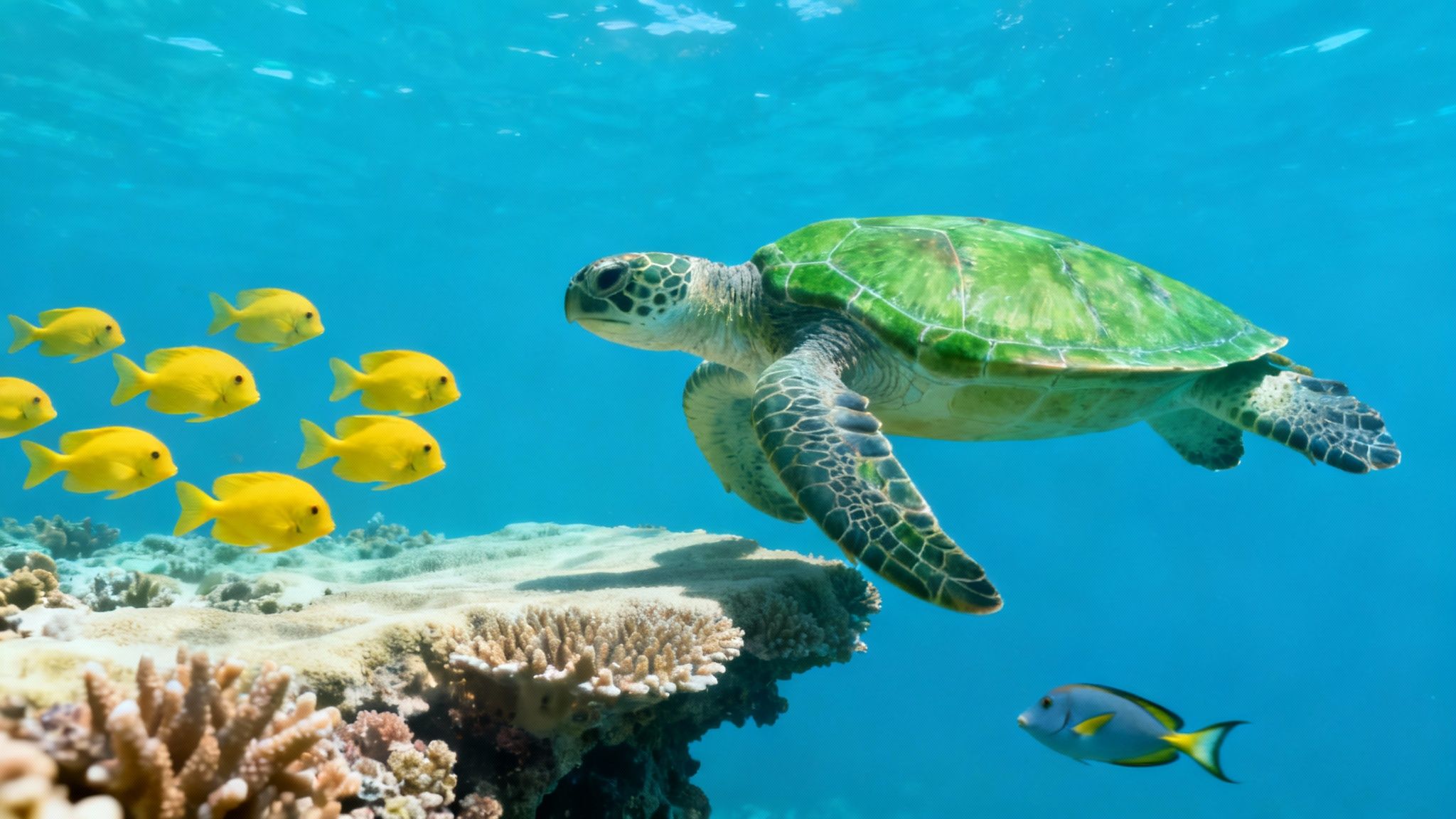
Get ready to meet the real locals of Kealakekua Bay. Dipping your face beneath the surface here is like peeking into a bustling underwater city, where the citizens are dazzling tropical fish and the skyscrapers are ancient coral formations. This isn't just another pretty snorkeling spot; it’s a protected Marine Life Conservation District, a special status that has allowed the entire ecosystem to absolutely thrive.
Because of this protection, the marine life is remarkably bold and abundant. The fish seem to know they’re safe, creating an experience where you feel less like an intruder and more like a welcome guest. With water clarity that often tops 100 feet, you get a front-row seat to one of nature's greatest shows.
The Stars of the Show
While every captain cook snorkel tour introduces you to a unique cast of characters, some residents are almost always around to say hello. The sheer density of fish is something you have to see to believe, turning the water into a living kaleidoscope of color and motion.
You’ll almost certainly find yourself mesmerized by massive, shimmering schools of yellow tang. These bright yellow fish move as one, a flowing river of gold that weaves through the coral heads. They are one of the most iconic sights in the entire bay.
Another frequent character is the Humuhumunukunukuāpuaʻa, Hawaii's state fish. Besides having a famously long name, this reef triggerfish is known for its quirky patterns and determined personality. Spotting one is a classic Big Island achievement.
Graceful Giants and Playful Pods
Beyond the endless schools of reef fish, Kealakekua Bay is a magnet for larger, more majestic creatures that can make your trip truly unforgettable. You’ll want to keep your eyes peeled for the gentle and ancient Hawaiian green sea turtles, or honu.
Watching a honu glide effortlessly over the reef is a serene, almost spiritual experience. These graceful reptiles are a beloved symbol of Hawaii's connection to the ocean and are protected by law. The best thing you can do is give them plenty of space and just enjoy watching them in their element.
It’s also pretty common for pods of playful spinner dolphins to visit the bay, especially on morning tours. While you'll watch them from the boat, seeing them leap and spin against the Kona coastline is a magical bonus. Their presence is a powerful reminder that the bay is a vital home for all kinds of marine life.
The protected nature of Kealakekua Bay means the marine life is not only abundant but also behaves more naturally. This allows you to witness interactions and behaviors you might not see in more heavily trafficked areas, offering a truly authentic glimpse into a healthy, thriving reef ecosystem.
Identifying What You See
Knowing what you're looking at can turn a beautiful swim into a fascinating wildlife expedition. Our guides are experts at pointing out different species, but having a little knowledge beforehand makes the whole experience richer.
You'll see a wide variety of fish, each with its own job on the reef:
- Parrotfish (uhu): Listen closely and you might actually hear them crunching on coral. They’re essential for the reef’s health, creating new sand as they clean algae off the coral.
- Butterflyfish (kīkākapu): These delicate, brightly colored fish often travel in pairs and are a joy to watch as they flit between coral branches.
- Moorish Idol (kihikihi): With their dramatic black, white, and yellow stripes and long, flowing dorsal fin, these are some of the most elegant fish you'll find.
To get a head start on recognizing the incredible creatures you'll meet, check out our detailed Hawaiian fish identification guide. It will help you put a name to all the new faces you'll see beneath the waves. Every snorkel becomes a treasure hunt when you know who to look for.
How To Prepare For Your Day On The Water
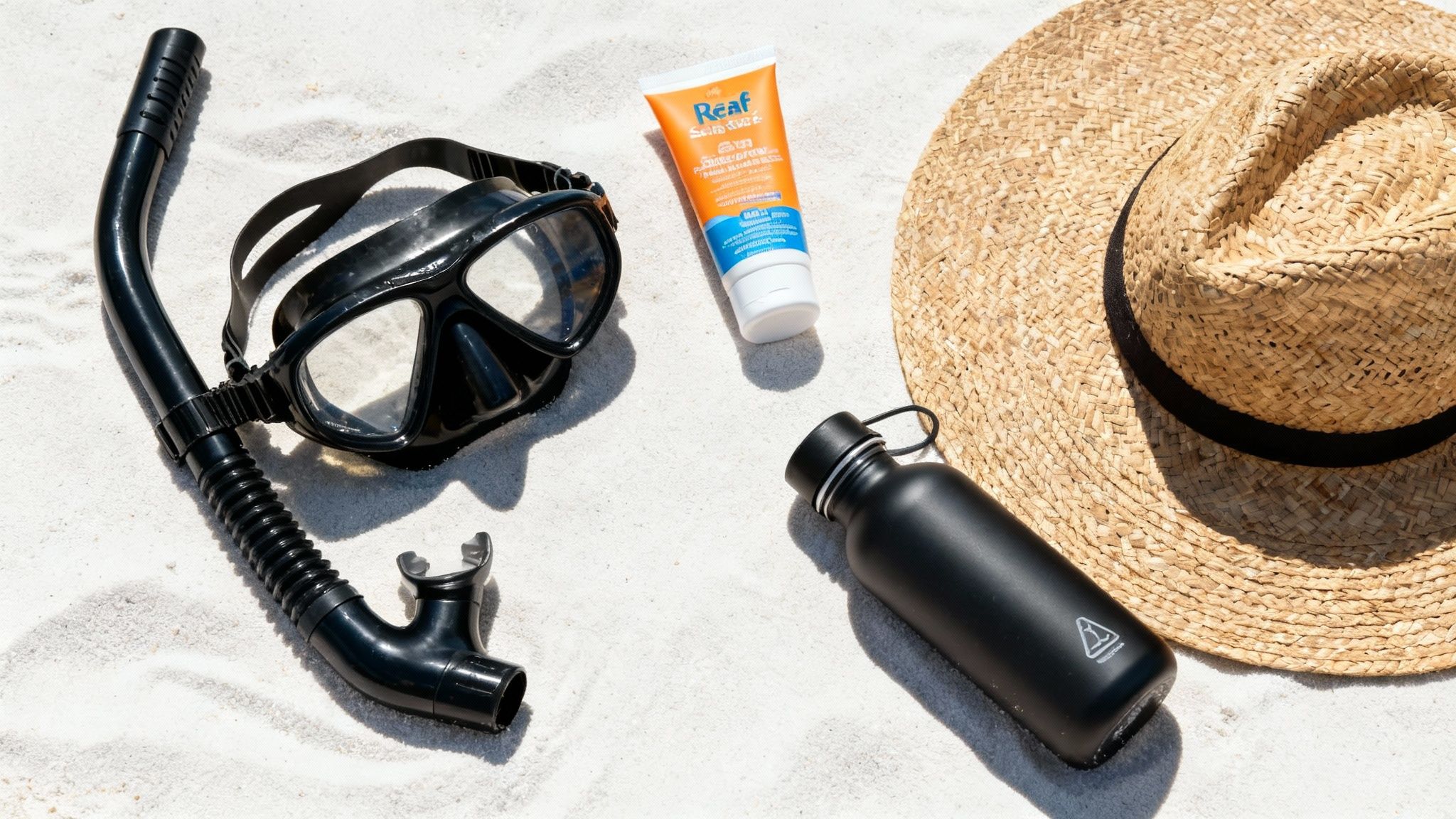
A little bit of planning is the secret ingredient for a perfect day on your Captain Cook snorkel tour. Thinking ahead about what to bring ensures your adventure is comfortable, safe, and totally stress-free from the moment you step on the boat. Think of this as your pre-departure checklist to get you primed for an incredible day exploring Kealakekua Bay.
The Hawaiian sun is no joke, especially when you're out on the water where its rays reflect from every angle. Getting ready for sun exposure isn't just a good idea—it's non-negotiable for a comfortable trip.
Beyond just protecting your skin, you also have a responsibility to help protect the amazing underwater world you’re about to explore. The vibrant coral reefs are living, fragile animals, and they are extremely sensitive to the chemicals found in most common sunscreens.
Packing Your Day Bag
Packing light is smart, but packing right is even smarter. Your day bag only needs a few key items to make a huge difference in how much you enjoy your time on the water. With these basics on hand, you can focus on the incredible scenery and marine life without any nagging distractions.
To make things easy, here’s a quick-reference table of what we recommend bringing along.
| Item Category | Essential Items | Recommended Extras |
|---|---|---|
| Sun Protection | Reef-safe sunscreen, polarized sunglasses, wide-brimmed hat | UPF rash guard or long-sleeved shirt, lip balm with SPF |
| Clothing | Swimsuit, towel, dry change of clothes for the ride back | Light jacket or windbreaker (for morning or breezy trips) |
| Gear & Personal | Reusable water bottle, any personal medications | Waterproof camera (GoPro, etc.), small amount of cash for tips |
Having these items sorted before you leave will set you up for a smooth, fantastic day. The most important thing on that list? Reef-safe sunscreen.
Remember, every choice you make as a visitor has an impact. Using reef-safe sunscreen is one of the easiest and most effective ways you can personally contribute to the preservation of Kealakekua Bay's delicate ecosystem for future generations.
Snorkeling Tips For All Skill Levels
Whether you’re a seasoned pro or it's your very first time putting on a mask, a few simple techniques can completely elevate your experience. Your guides will give you a full briefing on the boat, but keeping these tips in mind will help you feel confident the second you hit the water.
For beginners, the key is to get comfortable with your gear before you even leave the boat. To get a perfect, leak-free seal on your mask, hold it up to your face without the strap and gently inhale through your nose. If it sticks, you’ve got a good fit. This simple trick prevents that annoying trickle of water that can ruin the fun. Once you're in the water, focus on slow, calm, deep breaths through your snorkel—this conserves energy and keeps you relaxed.
For everyone, from first-timers to experts, moving efficiently is the name of the game. Your power comes from your fins, not your arms. Try to keep your body horizontal on the surface and use slow, deliberate kicks from your hips. This streamlined position saves a ton of energy and allows you to glide effortlessly over the reef, seeing more wildlife without getting tired.
While our tours provide excellent, high-quality equipment, we know some people prefer to bring their own. If you want to learn more about choosing your own gear, we've put together a helpful article covering the best gear for snorkeling on the Big Island Hawaii.
How to Be a Respectful Visitor
Kealakekua Bay is so much more than just another pretty place to snorkel. It's a living, breathing piece of Hawaiian culture and a delicate marine sanctuary. When you visit a treasure like this, it comes with a responsibility to be a mindful guest, ensuring it stays just as beautiful for everyone who comes after you. It’s all about shifting your mindset from being a tourist to becoming a steward of this incredible place.
The number one rule on any Captain Cook snorkel tour is simple: look, but don’t touch. This goes for everything you see in the water. That coral reef might look like a bunch of colorful rocks, but it's actually a massive colony of tiny, living animals. Just touching or standing on the coral can kill it, wiping out decades of growth in a single second.
Give Wildlife Its Space
Getting to see marine life in its own world is the absolute highlight of the trip, and being respectful about it makes the experience better for you and the animals. When you see a Hawaiian green sea turtle (honu), it's natural to get excited, but fight that urge to swim right up to it or chase it for a better photo.
- Keep Your Distance: A good rule of thumb is to stay at least 10 feet (3 meters) away from sea turtles and other marine animals. Give them room to breathe!
- Be a Quiet Observer: Just let the animals do their thing. When you hang back without interfering, you get to see their natural behaviors and they don't feel stressed or threatened.
- Never, Ever Feed the Fish: Tossing food to the wildlife messes up their natural diet and can make them dependent on people, which is bad news for the whole ecosystem.
How you act in the water has a direct impact on the health of the bay. A respectful visitor leaves nothing behind but bubbles, taking only memories and pictures while making sure the environment stays wild and untouched.
By following these simple ideas, you're actively helping to preserve Kealakekua Bay's natural beauty and cultural importance. Your mindful actions protect the fragile balance of this underwater paradise, making your own experience better and keeping the ecosystem healthy for years to come.
Your Top Questions Answered
Let's clear up some of the most common questions people ask about the Captain Cook snorkel tour. Getting these details handled upfront will help you book with confidence and get right to the fun part—looking forward to your trip.
Do I Need to Be a Strong Swimmer?
Not at all. This is probably the biggest myth out there. All you really need is to be comfortable getting in the water. Kealakekua Bay is incredibly calm and naturally protected from the big ocean swells, which makes it one of the safest places you can snorkel on the entire Big Island.
Every tour company is set up to welcome all skill levels, from folks who have never put on a mask to snorkeling pros. They’ll have great flotation gear like pool noodles or life vests, so you can just relax and float on the surface. Plus, the guides always run through a solid safety briefing and give snorkeling tips before anyone even touches the water.
What Is the Best Time of Year to Go?
Honestly, there's no bad time to snorkel at Captain Cook. The weather on the Big Island is pretty consistent, and Kealakekua Bay’s unique geography keeps it sheltered all year long. You're going to have an amazing time no matter which month you visit.
If you want the absolute calmest, glass-like water, the summer months from April through October are usually perfect. That said, winter is a fantastic time to go, too. You get the added bonus of possibly spotting humpback whales on their migration as you travel to and from the bay.
No matter the season, the most important tip is to book your tour well in advance. These trips are extremely popular and fill up quickly, especially during holiday periods and peak travel seasons.
Are There Restrooms on the Boats?
Good question! This is a key detail that really depends on the style of boat you choose for your tour.
- Larger Catamarans: These big, stable boats almost always have a restroom onboard (it’s called a “head” on a boat).
- Smaller Zodiacs/Rafts: Because they're smaller and more nimble, these adventurous boats typically do not have any restroom facilities.
When you're looking at different tour options, this is definitely something to check on the company's website. If having a restroom is important for your group's comfort, you’ll want to make sure you book a tour on a larger vessel.
Can I Bring My Own Snorkel Gear?
Absolutely. You're more than welcome to bring your own mask, snorkel, and fins if that's what you're comfortable with. A lot of people who own prescription masks or have gear that fits them perfectly choose to do this.
But it’s definitely not a requirement. Every good tour operator provides high-quality, sanitized snorkel equipment for everyone as part of the tour price. Unless you have a specific reason to bring your own, using the gear they provide is usually easier and works great for a fantastic day of snorkeling.
Ready to dive into the crystal-clear waters of Kealakekua Bay? Kona Snorkel Trips offers premier guided tours that blend adventure, history, and a deep respect for the marine environment. Book your unforgettable Captain Cook snorkel tour today at https://konasnorkeltrips.com.
